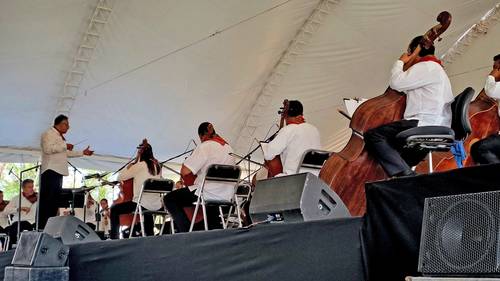Like another instrument, the locomotive OdeM2 blew his whistle Steam Symphony
Puebla, Pue., Carried by the Puebla State Symphony Orchestra (OSEP) and the Municipal Symphonic Band, the locomotive OdeM2 He blew his whistle and exhaled white smoke like another instrument of steam symphony, piece by Melesio Morales that celebrates 155 years since it was composed to inaugurate the Mexican Railway station in this city.
Steam Symphony It is also the name of the concert that the National Museum of Mexican Railways (MNFM) has organized since 2004, bringing together, in a railway environment, the notes of the symphony orchestra, the band and the train, as conceived by the Mexican composer in 1869.
Last Saturday, hundreds of people went to the second section of the museum attached to the federal Secretary of Culture to see the locomotive pass by, which became, for seconds, another note.
It is a work of which today I still have not found a piece that resembles it in the world; a work that incorporates the presence of a railway engine in the score
said Teresa Márquez Martínez, director of the MNFM and the National Center for the Preservation of Railway Cultural Heritage when opening the concert dedicated to the railway family
.
Next, the municipal Symphonic Band directed by Gabriel Xique Tepala performed a revolutionary medley with popular songs, such as The rail o Adelita, that encouraged the public.
The OSEP, directed by David Hernández Bretón, gave way to Music to chat, written in 1938 by Silvestre Revueltas (1899-1940) for the film documentary that recorded the construction works of the Sonora-Baja California railroad; was presented by its author as music to chat, to sleep, to drink tea, what do I know: music to not think
. Some fragments of the composition were played on the radio on October 22, 1938, and only two months later, on December 15, Revueltas himself conducted the premiere in its complete version at the Palacio de Bellas Artes, in which it would be a of his last public appearances.
The public also heard The four seasons by Arturo Márquez, piece written in 2005 expressly for the concert steam symphony, in which the composer takes the stops of Puebla, San Luis Potosí, Veracruz and Aguascalientes for his trip, represented in four movements: Puebla locomotive, Veracruz locomotive, Aguascalientes locomotive y Potosina locomotive, the same one that premiered at the 2006 concert.
It was the turn of Railway engine (Toccata railwayera), composition by Leonardo Coral that in 2005 was the winner of the first Melesio Morales Musical Composition Contest, which was “conceived in a single movement, in which the orchestra must be seen as an immense railway machine, which little by little begins to move until reach their maximum speed and power… Instrumental families are perceived as blocks that assemble and interact: gears, wheels, levers and hinges that work with strength, precision and vigor to achieve movement,” the author.
The chords continued in the piece Train 503, fantasy for orchestra about Mexican song The rail by Ryszard Siwy, which received an honorable mention in the second Melesio Morales Musical Composition Competition.
Finally, with the OdeM2 built by the HK Porter Locomotive Works in 1942, in Pittsburgh, Pennsylvania, which is part of the MNFM collections, it was interpreted steam symphony, piece by Melesio Morales, created for symphony orchestra, band and trains that reflects the richness of a city and a railway station.
This piece made Morales, author of more than 140 compositions, recognized as a pioneer of descriptive, evocative and machinist music for using real sounds of steam engines as another instrument in the orchestra.
Like a note marked in the score, the whistle of the locomotive resounded among the silence of the other orchestra instruments. At the same time, while some listened from their seats, others chose to get as close as possible to the locomotive, which moved a few meters while letting out its whistle. Everyone then agreed to give applause that mixed with the orchestra and the band, applause that exalted nostalgia for the railroad.
